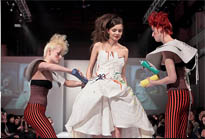Now in its seventh year, Toronto Arts and Fashion Week (FAT), continues to blur the boundaries between film, photography, dance, and fashion. With an eclectic mix of tastes, it seems, then, that there is something for everyone. Here are some of the collections that we spotted on Friday’s runway.
Wallace Playford
One part intergalactic space beauty competition, and another part “Who Are You, Polly Magoo”, Wallace Playford’s runway show was a frothy mix between vintage shapes, and futuristic neon-pastels. Opening with the cheerful-yet-ominous theme song from Twisted Nerve (Tarantino buffs may remember this as Elle Driver’s whistle), there was nothing terrifying about these candy-coloured confections.
Evoking the swinging-sixties, models shimmied down the runway, showing off the best of what the nebulas had to offer. Kitschy in its presentation, Wallace Playford gave us swimwear inspired looks, floral swimming caps, a-line sillouettes, and bullseyed tights. Think streamlined Judy Jetson. Standouts included a white dotted trapeze dress edged in vinyl added marvelous movement to a collection that at times felt, despite its best efforts––a tad static.
Haphazard Tormented
Influence really wore itself on its sleeve at the Haphazard Tormented show. When a white-hoop skirted dress was covered in fresh, jewel toned paint by a pair of creepy Harlequins––you couldn’t help but think of the late Alexander McQueen’s Spring/Summer show in 1999, where robots sprayed paint on a terrified-looking Shalom Harlow, rotating on a turn table.
Another inspiration, it seemed, was Vivienne Westwood––her autumnal colours, her trailing spools of fabric, and corsetry all seemed a part of Haphazard Tormented’s gothic mood. Hitting its stride when not directly referencing, this collection at times appeared less to be a cohesive presentation, and more a series of inspired vignettes.
The best part? A headdress fashioned from braided rope, perched precariously on two models’ heads. This was part of a conjoined twin-like gown in a deep, dusky mauve. The finale was a graffitied piece of fabric––a great wall of feet––parading out like a dancing, New Years dragon.
Von Bardonitz
With steeple-high mitres, and sloping, curved caps, the models at Von Bardonitz stomped it out to Austra’s goth-pop anthem “Feel it Break”. On the whole more wearable than many FAT collections, Berlin based Nicole Roscher gave us an unfussy, lost Bronte sister-in-the-twenty-first century cool. Juxtaposing the wearable with the religious, the result evoked an urbane Pope Innocent X. Much like Baconian renditions of Valasquez’s famous portrait, Von Bardonitz’s presentation captured moments of starkness and bleakness, and punctuated them with a well distilled anxiety. Moody and militaristic, the Von Bardonitz individual marched forth swathed in black sheers, with hints of vinyl. The floatiness of fabrics was tempered, if not flanked down by scores of gold cross accessories. Calling to mind Givenchy’s F/W 2008 in some places, Roscher gave us a dash of purity and danger. Simple, and refined––it was the smallest details that made this collection; different collars such as nehrus, and a Wednesday Adams-esque one showed us how well Roscher pays mind to the tiniest touches.
Pedram Karimi
Pedram Karimi presented an severe, complex geometry. Releasing ghoulish, downtown wraiths, there was a preciseness to Karimi’s work that allowed the work to flow as a whole. At once sculptural, as well as deconstructed, Karimi kept to the austere palate of blacks, and creams. Tunics were attached to two-toned leggings, creating an odd jump-suited effect. A shroud-like mullet dress was paired with severe, triangular heels; whilst a cape with a hooded dip was shown. There was an androgynous, art-school primness to Karimi’s jumpsuits, while exposed zippers hinted at an undone, imperfect feel. On one garment, there was a slight dhoti-esque gather that hit just before the pectoral line––certainly an interesting play on the empire waist.
Brankopopovic
Simple shapes with unusual tailoring, Brankopopovic showed menswear that can easily be translated to women’s wear. With simple shapes complicated by unusual tailoring, the Maastricht based Branko Popovic worked the strength of the triangle into his designs. Attaching them as exaggerated, flattened, cone-like shoulders on blazers or creating a diamond-like body bag, Popovic was all about angularity it seemed. Though he could take his designs into the realm of the conceptual, Popovic also offered us a simple, streamlined black trench––a staple for all you fashion mafia types.
~Natasha Hunt, photos courtesy Vasko Photography


















 Follow Us On Instagram
Follow Us On Instagram
